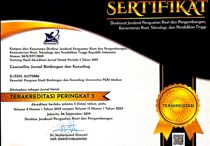POTRET EVALUASI PROGRAM BIMBINGAN DAN KONSELING DI SEKOLAH MENENGAH ATAS
DOI:
https://doi.org/10.25273/counsellia.v11i1.8670Keywords:
Evaluation, Guidance and Counseling.Abstract
Evaluation of guidance and counseling services should ideally be conducted periodically and continuously. Appropriate evaluation procedures will provide many benefits for teachers Guidance and counseling. Evaluation gives teacher guidance and counseling feedback to develop and improve programs. Evaluations also provide information to leaders about student development and improvement efforts. Proper evaluation results will help the counselor in achieving the goals of guidance and counseling services. This study aims to determine how the evaluation process is in high school. The research method uses a descriptive qualitative approach. Data collection techniques are interviews and observation. The sampling technique was carried out through a nonprobability sampling procedure. The results of this study indicate diversity in the evaluation process carried out by high schools. There are 6 (six) types of evaluations conducted by guidance and counseling teachers in high schools. The results of the study also illustrate the evaluation techniques and the purpose of schools conducting evaluations. We hope that the results of this study can provide information to improve the quality of evaluation in the Guidance and Counseling services in Indonesia.
Downloads
References
Arikunto, S. (2019). Dasar-dasar Evaluasi Pendidikan (edisi revisi).
Azizah, F., Ginting, F. B., & Utami, R. S. (2017). Evaluasi Pelaksanaan Program Layanan Bimbingan Dan Konseling Di Sekolah. In Prosiding Seminar Bimbingan dan Konseling (Vol. 1, pp. 177–188).
Cronbach, L. J., Ambron, S. R., Dornbusch, S. M., Hess, R. D., Hornik, R. C., Phillips, D. C., … Weiner, S. S. (1980). Toward reform of program evaluation. Citeseer.
Fitzpatrick, J., Christie, C., & Mark, M. M. (2009). Evaluation in action: Interviews with expert evaluators. Sage. DOI: https://doi.org/10.4135/9781412990288
Galassi, J. (2017). Strengths-based school counseling: Promoting student development and achievement. Routledge. DOI: https://doi.org/10.4324/9781315087641
Gysbers, N. C., & Henderson, P. (2014). Developing and managing your school guidance and counseling program. John Wiley & Sons.
Hennink, M., Hutter, I., & Bailey, A. (2020). Qualitative research methods. SAGE Publications Limited.
Huberman, M., & Miles, M. B. (2002). The qualitative researcher’s companion. Sage. DOI: https://doi.org/10.4135/9781412986274
Khairunisa, K., Rustam, A., Nurkholis, I., Mansyur, A. I., Maslikhah, M., & Badrujaman, A. (2019). Hubungan antara Keterampilan Evaluasi dengan Keterlaksanaan Evaluasi Program BK di SMA Se-Kecamatan Cilinci Jakarta Utara. JKI (Jurnal Konseling Indonesia), 5(1), 21–27. DOI: https://doi.org/10.21067/jki.v5i1.3491
Lichtman, M. (2012). Qualitative research in education: A user’s guide. Sage publications.
Mathison, S. (2004). Encyclopedia of evaluation. Sage publications. DOI: https://doi.org/10.4135/9781412950558
Mertens, D. M., & Stewart, N. (2014). The feminist practice of program evaluation. Feminist Research Practice: A Primer, 330–362. DOI: https://doi.org/10.4135/9781071909911.n11
Myrick, R. D. (2003). Accountability: Counselors count. Professional School Counseling, 6(3), 174–179.
Phillips, D. C. (2018). The Many Functions of Evaluation in Education. Education Policy Analysis Archives, 26(46). DOI: https://doi.org/10.14507/epaa.26.3811
Ratnawulan, T., & Rahman, S. A. (2017). MANAGEMENT PROFILE OF GUIDANCE AND COUNSELING IN JUNIOR HIGH SCHOOL. PEOPLE: International Journal of Social Sciences, 3(3). DOI: https://doi.org/10.20319/pijss.2017.33.334350
Shertzer, B., & Stone, S. (1966). Foundations of Guidance. New York: Houghton Mifflin Company.
Sink, C. A., Cooney, M., & Adkins, C. (2017). Conducting Large-Scale Evaluation Studies to Identify. International Handbook for Policy Research on School-Based Counseling, 133. DOI: https://doi.org/10.1007/978-3-319-58179-8_10
Sink, C. A., & Spencer, L. R. (2005). My Class Inventory-Short Form as an accountability tool for elementary school counselors to measure classroom climate. Professional School Counseling, 9(1), 2156759X0500900112. DOI: https://doi.org/10.1177/2156759X0500900112
Sudijono, A. (2008). No Pengantar Evaluai Pendidikan. Jakarta: PT. Raja Grafindo.
Sugiyo, S., & Muslikah, M. (2018). Evaluation Models of Guidance and Counseling Service Based Cipp in Senior High School. In 4th International Conference on Early Childhood Education. Semarang Early Childhood Research and Education Talks (SECRET 2018). Atlantis Press. DOI: https://doi.org/10.2991/secret-18.2018.41
Sukardi, D. K., & Kusmawati, D. P. E. N. (2008). Proses Bimbingan dan Konseling di Sekolah: untuk Memperoleh Angka Kredit. Jakarta: Rineka Cipta.
Tohirin, A., & Pd, M. (2007). Bimbingan Dan Konseling Di Sekolah Dan Madrasah. Jakarta: Raja Grafindo Persada.
Vedung, E. (2017). Public policy and program evaluation. Routledge. DOI: https://doi.org/10.4324/9781315127767
Whiston, S. C., Mitts, N. G., & Li, Y. (2019). Evaluation of career guidance programs. In International handbook of career guidance (pp. 815–834). Springer. DOI: https://doi.org/10.1007/978-3-030-25153-6_38
Winkel, W. S., & Hastuti, M. M. S. (2005). Bimbingan dan konseling di institusi pendidikan. Media Abadi.
Downloads
Published
Issue
Section
License
In order to be accepted and published by Counsellia: Jurnal Bimbingan dan Konseling, the author(s) submitting the article manuscript should complete all the review stages. By submitting the manuscript the author(s) agreed to the following terms:
The copyright of received articles shall be assigned to Counsellia: Jurnal Bimbingan dan Konseling. The intended copyright includes the right to publish articles in various forms (including reprints). Counsellia: Jurnal Bimbingan dan Konseling maintain the publishing rights to the published articles.
Authors are allowed to use their articles for any legal purposes deemed necessary without written permission from Counsellia: Jurnal Bimbingan dan Konseling with an acknowledgement of initial publication to this journal.
Author sent the copyright transfer form (here) to the journal.

This work is licensed under a Creative Commons Attribution-NonCommercial-ShareAlike 4.0 International License.






